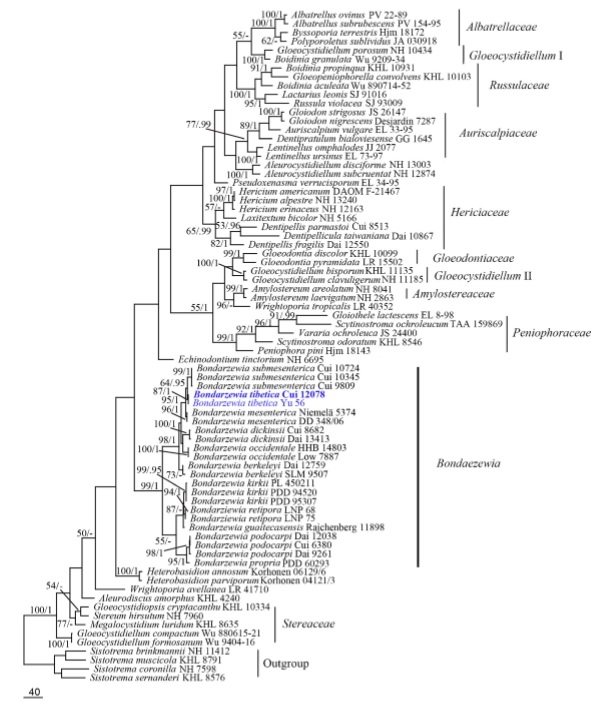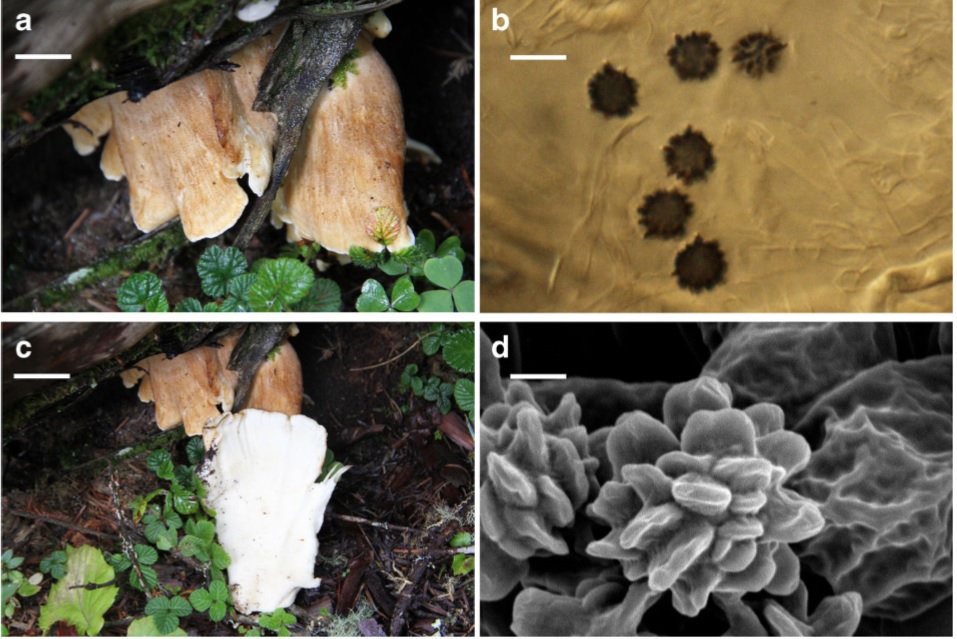Bondarzewia tibetica B.K. Cui, J. Song & Jia J. Chen
MycoBank number: MB 815274 Facesoffungi number: FoF 02055
Etymology: tibetica (Lat.), referring to the locality of the type specimen.
Holotype: BJFC 016992
Basidiocarps annual, pileate, broadly attached to the substrate, imbricate, soft corky and watery when fresh,becoming fragile up on drying; pileus fan-shaped, projecting up to 16 cm long, 25 cm wide and 2 cm thick; pileal surface cream to orange brown when fresh,olivaceous buff to deep olive when dry, a zonate, glabrous; margin white when fresh, becoming deep olive when dry; pore surface white to cream when fresh, becoming cream to buff when dry; pores irregular to angular, 1–3 per mm, mostly 1 per mm; dissepiments thin, entire to slightly lacerate; context white when fresh, up to 0.8 cm thick; tubes concolorous with the pore surface, up to 1.2 mm long. Hyphal system dimitic; generative hyphae simple septate; skeletal hyphae IKI–, CB –; tissues unchanged in KOH. Contextual generative hyphae seldom, hyaline, thick-walled, simple septate, 4–8μm in diam; contextual skeletal hyphae dominant, hyaline, thick-walled with a narrow to wide lumen, rarely branched, flexuous, interwoven, 4–10μm in diam. Tramal generative hyphae dominant, hyaline, slightly thickwalled to thick-walled, simple septate and numerous branched, 2–3.5 μm in diam; tramal skeletal hyphae rarely, hyaline, thick-walled with a narrow to wide lumen, rarely branched, flexuous, interwoven, 2–4μm in diam. Cystidia and cystidioles absent; basidia clavate, with a simple basal septum and four sterigmata, 35–58×9–11μm; basidioles in shape similar to basidia, but distinctly shorter. Basidiospores subglobose, hyaline, thick-walled, with obvious ridges, strongly amyloid, CB+, (5.5–)5.8–7×5–6.5(–6.8) μm, L=6.4μm, W=5.8μm. Ridges of spores blunt, up to 1 μm long.
Type of rot: White rot.
Material examined: CHINA: Xizang Autonomous Region (Tibet), Milin County, Nanyigou Park, on fallen trunk of Picea, 16 Sep 2014, Cui 12078 (holotype, BJFC 016992); ibid, Linzhi County, Bayi, on fallen trunk of Picea, 16 Aug 2004, Yu 56 (paratype, IFP 000968); Milin County, Nanyigou Park, on fallen trunk of Picea, 16 Sep 2014, Cui 12079 (paratype, BJFC 016993).
Notes: Bondarzewia tibetica is found on Picea in Xizang Autonomous Region of China. It is characterized by its cream to orange brown pileal surface, white to cream pore surface, small pores, a dimitic hyphal system, and large basidiospores with blunt spines. Bondarzewia dickinsii (Berk.) Jia J. Chen, B.K. Cui & Y.C. Dai, B. occidentalis Jia J. Chen, B.K. Cui & Y.C. Dai and B. podocarpi Y.C. Dai & B.K. Cui are morphologically similar to B. tibetica; they all produce similar pileal surface and pore surface; however, B. dickinsii is different by producing a mono mitichyphal system and sharp basidiospore spines; B. occidentalis is separated by its larger basidiospores and pores; B. podocarpi is different by producing sharp basidiospore spines (Chen et al. 2016; Dai et al. 2010). Phylogenetically, all species of Bondarzewia formed a monophyletic lineage belonging to Russulales.

Phylogeny of species in Bondarzewia and related species generated by maximum likelihood based on ITS+nLSU sequence data. Branches are labeled with bootstrap proportions (before the slash markers) higher than 50 % and Bayesian posterior probabilities (after the slash markers) more than 0.95. New taxa are in blue and ex-type specimens in bold

